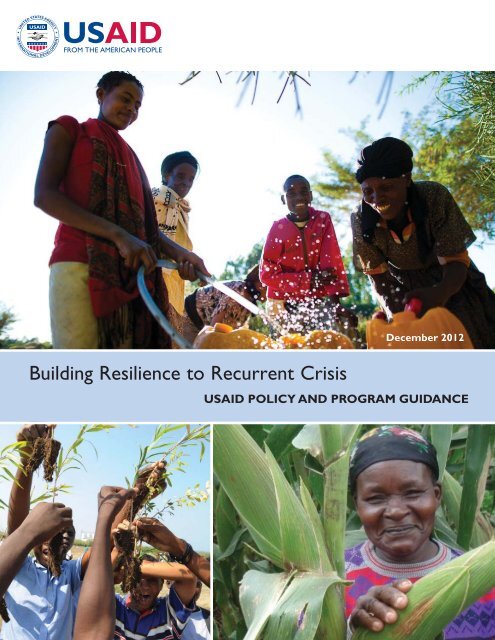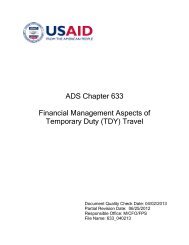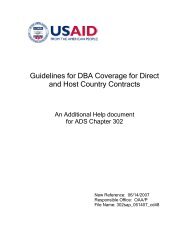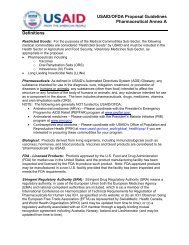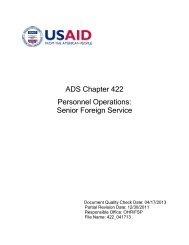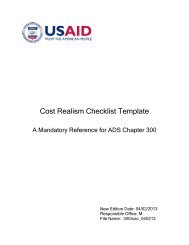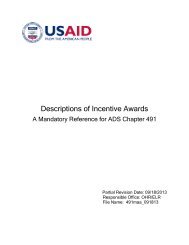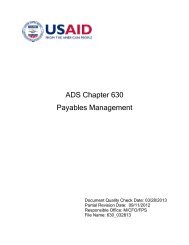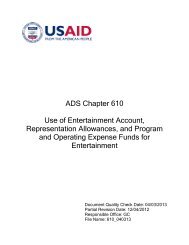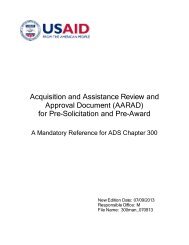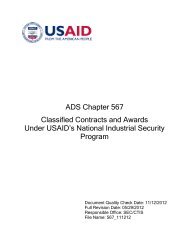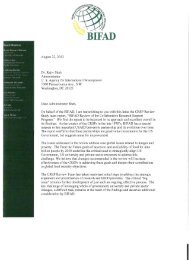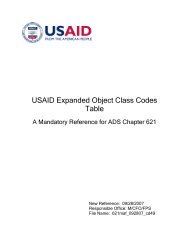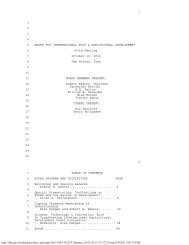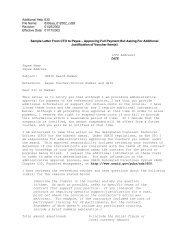USAID Policy Document - Resiliency FINAL 11-26-12.indd
USAID Policy Document - Resiliency FINAL 11-26-12.indd
USAID Policy Document - Resiliency FINAL 11-26-12.indd
- No tags were found...
You also want an ePaper? Increase the reach of your titles
YUMPU automatically turns print PDFs into web optimized ePapers that Google loves.
Cover photo credits: (clockwise from top)Morgana Wingard;Paul Seward/Farm Input Promotions Africa–Kenya Maize Development Program;Siaka Millogo.
Building Resilience to Recurrent Crisis<strong>USAID</strong> POLICY AND PROGRAM GUIDANCE
Table of ContentsLetter from the Administrator 3Executive Summary 5Introduction 7Framing Resilience 9The Results We Seek 9Conceptual Framework 10Selecting Areas of Focus 13Key Resilience Principles 16Core Operational Principles 17An Agenda for Operational Change 18Joint Problem Analysis 19Coordinated Strategic Planning 20Mutually Informed Project Designs and Procurements 22Robust Learning Agenda 23Conclusion 24Selected Resources 251
Letter from the AdministratorI am pleased to present <strong>USAID</strong>’s fi rst-ever policy and program guidance on building resilience to recurrent crisis. Drawn fromdecades of experience providing humanitarian relief and development assistance, this guidance aims to reduce chronic vulnerabilityand promote more inclusive growth in areas of recurrent crisis. Ultimately, we seek to save and improve lives and decreasethe need for repeated infusions of humanitarian assistance in these areas.The importance and urgency of this work has been made clear over the past year. In 20<strong>11</strong>, the worst drought in 60 yearsplunged 13.3 million people into crisis in the Horn of Africa. Only a few months later, another crisis emerged in the Sahel, wheremillions of people have suffered from the devastating impacts of drought, confl ict, and other pressures. The widespread needseen in these two regions refl ects similar diffi culties facing communities across the globe; in far too many places, families oftenrely on humanitarian assistance, year after year, just to survive.In response to these emergencies, the international community provides signifi cant levels of lifesaving relief, largely concentratedin just a few countries. Over the last decade, approximately US $90 billion was spent by international donors in just nine countries,accounting for almost 50 percent of all humanitarian assistance during this period. During the same time, three-quartersof <strong>USAID</strong> humanitarian assistance was spent in just 10 countries. Global trend lines and projections show clear and continuinggrowth in humanitarian need in certain regions, and climate change threatens to exacerbate both the frequency and severity ofextreme weather events and undercut important development gains.We can do better. That’s why <strong>USAID</strong> is working with committed and accountable governments and international partners tobuild resilient societies even while saving lives in times of crisis. While we cannot stop shocks from happening, we must increaseour focus on helping people and their societies withstand and recover from them. In the Horn of Africa, for example, we haveset a goal to directly benefi t 10 million people and reduce the region’s emergency caseload by 1 million people within 5 years.We expect to defi ne and realize similarly transformative impact in other areas where we apply this policy and program guidance.To do so, we are committed to identifying how to measure a broader range of results, with stronger monitoring and evaluationmechanisms for resilience.In order to reach these goals, we must strengthen the way we work as an agency. Too often, our humanitarian and developmentteams operate in separate geographic locations, on separate problems, with separate goals. To effectively build resilience we mustunite our approaches. While this is not an easy commitment, it is an important one, and we have begun to make progress. Overthe past year in the Horn of Africa and the Sahel, for example, we have created integrated agency units – called Joint PlanningCells – that are working to comprehensively address both humanitarian and development needs in close coordination withcountry governments and international partners. The effort of these teams demonstrates the powerful effect that we can havewhen we operate as a united Agency toward a singular goal. Leadership at all levels, in the fi eld and in Washington, is committedto facilitating and supporting the innovations necessary in our programming and operations to achieve our goals.We undertake these efforts because we believe they will strengthen our ability to save and improve lives. No one should have toface the crippling circumstances we have seen in the Horn of Africa and the Sahel over the past year. Through building resilience,we can help prevent that desperation, save lives, and create the conditions where families and communities can prosper.Dr. Rajiv J. Shah<strong>USAID</strong> AdministratorDecember 20123
Executive SummaryWhile we cannot stop shocks from happening, the U.S. Agencyfor International Development (<strong>USAID</strong>) can – and must – domore to help people withstand them. <strong>USAID</strong> has been in thevanguard of international momentum to support country andregional plans and build resilience to recurrent crisis. Throughthis policy and program guidance, we will leverage the broadrange of our institutional capabilities to implement innovativeprogrammatic approaches to promote resilience. Through theseefforts, we will draw on our mandates to provide lifesaving humanitarianassistance and longer-term development assistance 1(including our Development Assistance, Global Health, andEconomic Support Funds accounts).What Is Resilience?For <strong>USAID</strong>, resilience is the ability of people, households,communities, countries, and systems to mitigate, adapt to,and recover from shocks and stresses in a manner thatreduces chronic vulnerability and facilitates inclusive growth.KEY COMPONENTS OF RESILIENCEWhile the concept of resilience has broad applicability to manyof the environments in which our Agency works, this guidanceis specifi cally focused on areas where chronic poverty intersectswith shocks and stresses to produce recurrent crises andundermine development gains. In these places, we must increaseadaptive capacity – the ability to respond quickly and effectivelyto new circumstances – and improve the ability to address andreduce risk.We will emphasize approaches that empower women andmore effectively reduce gaps between males and females.Functioning institutions of good governance and democraticaccountability are also essential; building resilient countries andsystems requires effective and inclusive governments that holdthemselves accountable for results. Working closely with otherU.S. Government agencies, international donors, multilateralorganizations, and other partners, we will elevate and supportinclusive country-led plans that lead to sustainable reductions invulnerability and promote inclusive growth.AN AGENDA FOR OPERATIONAL CHANGEOur success in achieving these goals requires that we establishresilience to recurrent crisis as a common objective across ourdevelopment and humanitarian programs. While we will maintainboth the lifesaving speed of humanitarian assistance andthe longer-term focus of development assistance, we will alsoidentify opportunities to layer, integrate, and sequence these corecapabilities to achieve results.THE RESULTS WE SEEKOur efforts to build resilience will contribute to a sustainable reduction in vulnerability and more inclusive growth. Inthis pursuit and in the areas where we apply this policy and program guidance, we intend that our efforts will result in:• increased adaptive capacity• improved ability to address and reduce risk• improved social and economic conditions of vulnerable populationsOver the long-term, we envision that these results will collectively contribute to reduced humanitarian need, and metricswill be developed to capture these results.Ultimately, we seek to save and improve lives. In the Horn of Africa, for example, we aim to benefi t directly 10 millionpeople and reduce the region’s emergency caseload by 1 million people within 5 years. We are defi ning a comparableexpectation for impact in the Sahel, based on local conditions, and will likewise develop metrics for impact in otherfocus countries and regions moving forward.1 For the purposes of this guidance, the term “development assistance” refers to funding in our Development Assistance, Global Health, and Economic Support Fundsaccounts.5
In particular, our:HUMANITARIAN ASSISTANCE will seek more opportunitiesto reduce vulnerability and lay the foundation for longer-termdevelopment while continuing its primary focus on saving lives,and ourDEVELOPMENT ASSISTANCE will undertake longer-termprogramming in chronically vulnerable communities and besuffi ciently fl exible in higher-risk areas to build resilience andfacilitate inclusive growth.Under this guidance, <strong>USAID</strong> is institutionalizing change by ensuringthat integrated teams of humanitarian reliefand development experts work together to better understandeach other’s strengths and constraints and undertake:1. Joint Problem Analysis and Objective Setting so teams have acommon understanding of the underlying causes of recurrentcrisis.2. Intensifi ed, Coordinated Strategic Planning around Resilience toensure that we anticipate risks, vulnerabilities, and probablehumanitarian need when deciding on development strategies.3. Mutually Informed Project Designs and Procurements to enablethe layering, integrating, and sequencing of humanitarian anddevelopment assistance.4. Robust Learning so we can develop the appropriate indicators,make midcourse corrections, and share lessons learnedacross the Agency and with external partners.These efforts will be supported by leadership action to addressbarriers to organizational change. At the heart of this documentis our commitment to empower solution-holders closeto the problem; leadership at every level will remain committedto addressing unnecessary roadblocks that stand in the way ofmeeting our objectives.6
IntroductionIn September 20<strong>11</strong>, at the Nairobi Summit on the Horn ofAfrica Crisis, African leaders called for a new approach to addressingrecurrent crisis in the region. Based on the widespreadrecognition that current trends and past experience dictateda new approach, the Joint Declaration from this summit calledon development partners to “walk” and ”work” with Africanleaders to support long-term programs and strategies to buildresilience. They specifi cally called on the international communityto support reform of the emergency humanitarian responseand development assistance systems to enhance resilience andpromote long-term solutions, 2 recognizing the way they worktogether will have signifi cant impact on the results we are ableto achieve.This call emphasizes growing international recognition that, asa community and as individual donors, we must build uponprevious efforts to strategically coordinate our humanitarianresponse and longer-term development assistance 3 in a way thatelevates country- and regional-led plans and catalyzes sustainable,transformational change. Reducing chronic vulnerabilityand building resilience require interdependent and multisectoralapproaches that combine strong technical solutions with newoperational approaches. It also requires that we work in closecoordination with a wide range of partners; the spotlight oninternational partnerships below describes the Global Alliancefor Action for Drought Resilience and Growth in the Horn ofAfrica and the Global Alliance for Resilience in the Sahel (AGIR-Sahel), which play important coordination roles in these regions.We will continue to deliver lifesaving humanitarian assistancewhere crises occur. But we will also focus on doing better. Asa global community and as partners in the recovery of com-We must strategically coordinate humanitarian and developmentassistance in a way that catalyzes sustainable, transformational change.Spotlight on International Partnerships:The Global Alliance for Action for Drought Resilience and GrowthThe Global Alliance committed development partners to better coordinate, harmonize, and align their programs and policies to enhanceresilience against chronic drought and promote economic growth in the Horn of Africa and the Sahel.Active Work Streams:Support for the development of common country and regionalprogramming frameworks, regional capacity building and monitoringand evaluation frameworks.<strong>USAID</strong>’s Role:Assist regional organizations and governments to reduce chronicvulnerability to drought emergencies and enhance resilience, especiallyin dryland areas.April 2012June 2012July 2012Important Dates<strong>USAID</strong>, together with African and international development partners, co-hosted a Joint Intergovernmental Authorityon Development (IGAD) Ministerial and High Level Development Partners Meeting on drought resiliencein Nairobi that established a new Global Alliance for Action for Drought Resilience and Growth in the Horn ofAfrica. The Global Alliance is supporting the completion of technically rigorous Country Program Frameworksthat will enable donors, including <strong>USAID</strong>, to closely align programs and funding with plans developed and ownedby governments of drought-affected areas.<strong>USAID</strong> convened the fi rst meeting of the Global Alliance in Geneva.Global Alliance for Resilience in the Sahel, AGIR-Sahel, was established under the leadership of the EuropeanUnion and will work closely with the Global Alliance for Action for Drought Resilience and Growth in the Hornof Africa. It proposes a roadmap for better coordination of humanitarian and development efforts in the Sahelregion. <strong>USAID</strong> will be focusing on helping to build the resilience of households, communities, and systems in themost vulnerable agropastoral and marginal ecological zones.2 East African Community, Inter-Governmental Authority on Development, and the Republic of South Sudan. “Ending Drought Emergencies: A Commitment to SustainableSolutions” http://www.statehousekenya.go.ke/speeches/kibaki/sept20<strong>11</strong>/NBI_DECLARATION_20<strong>11</strong>090902.pdf3 For the purposes of this guidance, the term “development assistance” refers to funding in our Development Assistance, Global Health, and Economic Support Fundsaccounts.7
By layering, integrating, and sequencing humanitarian anddevelopment assistance, we can further the objectives of eachto a greater extent than by programming in isolation.munities suffering from recurrent crisis, we cannot be satisfi edby continual cycles of suffering from one humanitarian crisisto the next. While we cannot stop shocks from occurring, wecan do much more to help people withstand and recover fromthem, creating a platform for their continued development. Bylayering, integrating, and sequencing humanitarian and developmentassistance, we can further the objectives of each toa greater extent than by programming in isolation. Throughsuccessfully capitalizing on their individual and shared purposesand strengths, we believe that, over the long term, our effortscan result in reduced humanitarian need where we apply thispolicy guidance.This policy and program guidance provides an operational visionfor the Agency intended to increase our effectiveness. Thisguidance will help us draw important lessons from the Horn ofAfrica and the Sahel, where heightened international attentionand strong leadership have created opportunities to innovateand build resilience. Although the actions required to buildresilience are likely to look different in different contexts thatface unique shocks and stresses, our experience in the Hornof Africa and the Sahel will provide key insights as we expandour focus to other areas. Identifi cation of additional areas offocus 4 will be guided by historic patterns of shocks, stresses, andhumanitarian need, among other factors. We also intend to issuemore detailed operational and program guidance and toolsto inform the implementation of this policy. This guidance willinform our work with partners, including those within the U.S.Government, who are indispensable to these efforts. The scopeof the problem requires concerted and concentrated action byall stakeholders.4 Beyond the Horn of Africa and the Sahel, this guidance will also be applied to other areas of recurrent crisis based on analysis of a variety of factors (see “SelectingAreas of Focus”) and through conversation between <strong>USAID</strong>/Washington and our fi eld missions.8
Framing ResilienceFor the purposes of this policy guidance, <strong>USAID</strong> views resiliencein the face of recurrent crisis as:the ability of people, households, communities, countries,and systems to mitigate, adapt to, and recoverfrom shocks and stresses in a manner that reduceschronic vulnerability and facilitates inclusive growth.Shocks and stresses take many forms. Dramatic events suchas hurricanes, earthquakes, or tsunamis can have a devastating,immediate impact. Stresses can take less apparent but insidiousforms and often have more gradual onsets than shocks, includingevents such as drought, global economic volatility, or naturalresource depletion. In areas of chronic poverty, for example, asimple increase in food prices can trigger signifi cant underlyingvulnerability and result in crisis. Confl ict can be both a shock aswell as an underlying source of stress that can make communitiesmore vulnerable to other shocks when they hit.The actual impact of any given shock or set of stressors at thecommunity level is largely determined by the magnitude of thehazard itself, combined with the vulnerability to the shock and thecapacity of those affected to withstand them. In the most catastrophiccase, a shock can completely overwhelm a community tothe point of collapse. At a less extreme level, a society may eventuallyrecover, but diminished livelihoods and resources may leaveaffected populations worse off and more vulnerable than before.Source: Neil Thomas/<strong>USAID</strong><strong>USAID</strong> strives to build resilience so that, in the face of stressesand shocks, the communities where we work are preparedand able to take anticipatory action to avoid major losses,and in the event that crisis results, they are able to respondeffectively and build back better than before. This continuedpath of growth – even in the face of potential setbacks – is acritical component of our work.THE RESULTS WE SEEKOur approach to resilience requires that we identify ways to layer, integrate, and sequence our humanitarian reliefand development assistance. We will specifi cally identify ways for our humanitarian assistance to seek more opportunitiesto reduce vulnerability and lay the foundation for longer-term development while continuing its primary focus onsaving lives and for our development assistance to undertake longer-time programming in chronically vulnerable communitiesand be suffi ciently fl exible in higher-risk areas as a means to build resilience and facilitate inclusive growth.Our efforts to build resilience will contribute to a sustainable reduction in vulnerability and more inclusive growth. Inthis pursuit and in the areas where we apply this policy and program guidance, we intend that our efforts will result in:• increased adaptive capacity,• improved ability to address and reduce risk, and• improved social and economic conditions of vulnerable populations.Over the long-term, we envision that these results will collectively contribute to reduced humanitarian need, and metricswill be developed to capture these results.Ultimately, we seek to save and improve lives. In the Horn of Africa, for example, we aim to benefi t directly 10 millionpeople and reduce the region’s emergency caseload by one million people within fi ve years. We are working to identifycomparable expectation for impact in the Sahel, based on local conditions, and will likewise develop metrics for impactin other focus countries and regions moving forward.9
CONCEPTUAL FRAMEWORK<strong>USAID</strong>’s conceptual framework for resilience distillsthe key components of our approach and is intendedto provide a broad frame for country and regionalteams to consider as they develop context-specifi cstrategies. At its core is the idea that we are likelyto fi nd recurrent crisis in places where chronicpoverty and exposure to shocks and stressesintersect. We will focus our efforts to buildresilience in these areas, where there is oftenlow capacity to manage shocks.To increase resilience, communities needboth adaptive capacity and the ability toaddress and reduce risk. Adaptive capacity isthe ability to quickly and effectively respondto new circumstances. This includes ensuringthat social systems, inclusive governancestructures, and economic opportunities arein place. While the components of adaptivecapacity are numerous and wide-ranging,<strong>USAID</strong> places a priority on the fi ve displayed inthe conceptual framework. Equally important isan ability to analyze and reduce risk through preparedness,mitigation, prevention, and protection.In areas where adaptive capacity and risk reductionstrategies are weak, shocks and stresses often undercutdevelopment gains, setting communities back on thepath of inclusive growth.Building Resilience in Burkina Faso: Safieta’s StoryIn February 2012, after a year of bad rains, a group of four womenfarmers in Burkina Faso were unable to harvest much of themaize they had planted during the rainy season. Between them,they had 31 children and no husbands. But thanks to a <strong>USAID</strong>-Catholic Relief Services program started 7 years ago to increasethe resilience of villagers dependent upon rain-fed crops, theydid have land plots they were able to fill with bright green onionsprouts. Key to their success was obtaining secure access to land,small-scale irrigation investments, and training on new crops.While the program ended 2 years ago, these farmers, includinga proud woman named Safieta, are continuing to thrive on theproceeds of their dry season market gardens. “We chose onions,”she noted, “because if the water pump fails for a few days, they arestrong enough to survive.”Source: Siaka Millogo“I am resilient now,” Safi eta said, laughing. “Just like the onions.”10
Drawing Lessons from Ongoing Resilience Activities:Global Climate Change and DevelopmentClimate change is a major stress that must be considered in designing strategies tobuild resilience. Taking steps to anticipate and incorporate plans for responding topotential climate change impacts into economic and political systems is referredto as “adaptation.” Climate adaptation requires that we utilize science, technology,innovation, and the best available information to understand and respond tounavoidable impacts. <strong>USAID</strong>’s Climate Change and Development Strategy’s secondstrategic objective is “Increasing resilience of people, places, and livelihoods”through investments in improved access to science and analysis for decision making,effective governance systems, and replicating and scaling up proven successes.<strong>USAID</strong> is working to incorporate new norms from the start – from rising temperaturesto more variable rainfall and greater incidence of drought to strongerstorms.<strong>USAID</strong>, as part of the President’s Global Climate Change Initiative, promotes theintegration of climate change to support food security, health, governance, anddisaster risk reduction (DRR), among other goals. For example, <strong>USAID</strong> is pilotingpreventative, longer-term approaches to DRR than is typical in traditionalDRR, which works only in areas that are faced with specific hazards. Considering the current and future effects of climatechange allows us not only to better predict, prepare for, and respond to shocks and stresses (e.g., hurricanes, flooding, anddroughts) but also to improve planning for the long-term stresses of climate change. The Global Climate Change Initiativeis a critical component of our overall resilience efforts; appropriately applying this guidance to climate change programswill strengthen our ability to achieve our objectives.The components of the conceptual framework are meantto guide our work rather than comprise a checklist. Everycontext will require a tailored approach, and <strong>USAID</strong>’s specific contributions to building resilience will be adapted in away that aligns and complements country and regional plansand works to strengthen the country enabling environmentthrough support for appropriate policies and reforms. In addition,our approach focuses on close coordination with otherpartners, including other U.S. Government agencies, internationaldonors, nongovernmental organizations, civil society, andthe private sector.In developing a resilience strategy, multisectoral considerationsmust be taken into account. For example, a focus on droughtresistantagriculture and livestock could be supported by workto strengthen effective institutions to monitor and disseminateforecasts, provide extension services, and strengthen fi nancialservices that promote savings and insurance. Attention shouldbe paid to different groups within communities; for example,investing in youth, who play increasingly prominent and intergenerationalroles as agents of recovery and change, should beseen as foundational to reducing risk. Many underlying factorsmay also increase vulnerability and should be considered.Population growth, for example, is increasing pressures in manyplaces of recurrent crisis, signaling that efforts to meet the unmetneed for family planning may be a necessary component ofa larger strategy to build resilience. Helping vulnerable communitiespredict, prepare for, withstand, and recover from shocksand crises through disaster risk reduction efforts and earlywarning systems, such <strong>USAID</strong>’s Famine Early Warning System(FEWSNET), will continue to be an important part of <strong>USAID</strong>’sapproach.We must also provide relief and promote development in waysthat more effectively reduce gaps between males and femalesand involve and meet the different needs of men and women. 5Despite the fact that women often face a range of unique challengesin areas of recurrent crisis – and often bear the heaviestburden of shocks and stresses – they also possess enormousindividual and collective capacity to help themselves, theirfamilies, and their communities. A 2009 study examined therole of Sudanese women in improving household food securityand suggested that rural women are more likely than men to effectivelyuse available local resources in diversifi cation strategies.Furthermore, women with adequate access to food productionsources (i.e., agricultural land, home gardens, and backyard5 Consistent with <strong>USAID</strong>’s <strong>Policy</strong> on Gender Equality and Female Empowerment, we use data analyses that inform strategy and program design, and our programs addressthe different priorities, needs, and vulnerabilities of women and men; reduce gaps between men and women; engage females as leaders and implementing partners; and createeffective monitoring and evaluation metrics that hold us accountable for delivering results for women and other marginalized groups.<strong>11</strong>
Building Resilience:The Role of Disaster Risk ReductionDisaster risk reduction (DRR) interventions are aimedat reducing the risk associated with specific types ofhazards and disasters. In contrast to general developmentprograms or broader resilience programming,DRR programs focus on potential hazards or shocksand generally target groups that are particularly vulnerableto these hazards and risks. <strong>USAID</strong>’s DRR programsfocus specifically on (1) prioritizing and strengtheningearly warning, preparedness, mitigation, and prevention;(2) integrating preparedness and mitigation with disasterresponse, early recovery, and transitions to foster resilience;and (3) supporting diversified livelihood strategies.For instance, a DRR program might assist a communityliving in a seismically active zone with devising protocolsand procedures to respond to earthquakes or tsunamis.Similarly, a DRR program might assist city planners inflood-prone areas with shoring up rural and urban infrastructureto mitigate the negative impacts of flooding.Resilience, on the other hand, seeks to reduce risk ina broader sense by strengthening the ability of people,households, communities, countries, and systems tocope with both anticipated and unanticipated negativeshocks across a wider range of different areas ofintervention. While DRR programs are central to thegoal of building resilience, they are not sufficient in andof themselves. Becoming resilient requires a range ofapproaches to help communities develop the capacityto manage the range of challenges that threaten stability,whether sudden or longer term, urban or rural,natural or human-made. DRR programs are one partof the solution; to achieve resilience in any given area,a broader concerted and coordinated effort by bothdevelopment and humanitarian actors is required. Theseapproaches should integrate DRR with a diverse combinationof other interdependent activities that contributeto increasing adaptive capacity, improving the ability toaddress and reduce risk, and improving the social andeconomic conditions of vulnerable populations.plots), different sources of incomes, and the capacity to controlthe choice of foods being prepared and consumed are betterable to improve their household’s food security and nutrition. 6Approaches that systematically and visibly reduce key gendergaps and ensure that women are given the tools, resources, andopportunities to lead and participate are critical to the successof our efforts to achieve sustainable change.Source: <strong>USAID</strong>Pineapple pioneer Masum Ahmed showcases his contoured pineapple field inHail Haor, Bangladesh.Functioning institutions of good governance and democraticaccountability are essential to developing a country’s adaptivecapacity and its ability to address and reduce risk. Good governancerequires institutions and processes that are transparent,accountable, and responsive to the people they serve and thatpromote positive state-society relationships (including a strongcivil society and a vibrant private sector). Governance capacitydetermines the ability of the state to respond effectively to crisesand to address the long-term development needs requiredto effectively address recurrent issues. Furthermore, goodgovernance is crucial to prevent and mitigate confl ict, whichplays a detrimental role in many of the communities where weare applying a resilience approach and which has, in past effortsto build resilience, stood decisively in the way of sustainableprogress.Any approach that seeks to build resilience must be informedby confl ict dynamics, as humanitarian need may be great inareas emerging from confl ict or still fragile. Programming thatintegrates confl ict resolution and peace building, and strengthensinstitutions of good governance, plays an important role incontributing to the sustainability of development gains. In fragilestates where these challenges are particularly acute, the NewDeal for Engagement in Fragile States 7 provides both a normativeframework and top-level guidance for focusing the combinedefforts of host country leaders and international donorson inclusive politics and strengthening institutions of governance,which are essential to building states, peace, and resilience.The links between the many important factors required to buildresilience are complex. The challenge is to determine whichinstitutional, policy, and political constraints pose the most signifi -cant impediments to building resilience and which are amenable6 Ibnouf, Fatma. “The Role of Women in Providing and Improving Household Food Security in Sudan: Implications for Reducing Hunger and Malnutrition.” Journal of InternationalWomen’s Studies, Web. http://www.bridgew.edu/soas/jiws/May09/SudanFoodSecurity.pdf.7 Find more information on the New Deal for Engagement in Fragile States at http://www.aideffectiveness.org/busanhlf4/about/new-deal-for-engagement-in-fragile-states.html.12
to reform and change through programmatic interventions.This includes deciding the appropriate level at which to engage.Often, communities that face recurrent crisis are also areas thatreceive limited political attention. Sustainable progress requires adeliberate shift in this dynamic. It is the responsibility of governmentsat all levels to ensure that these vulnerable communitiesreceive the appropriate support, and it is the responsibility ofinternational partners to support that transition to more robustengagement. Making an entire sector, system, or nation moreresilient requires a complex level of engagement with hostcountry partners that are able to exercise key state functionsand demonstrate the political will for reform in areas wherestructural problems interfere with or undermine resilience.SELECTING AREAS OF FOCUSWhile the concept of resilience has broad applicability to manyof the environments in which we work, this policy and programguidance is specifi cally focused on areas of recurrent crisis – thearea of intersection where chronic poverty overlaps with shocksand stresses – and where high levels of humanitarian assistancehave historically been dedicated and/or where shocks andstresses create signifi cant loss.The initial application of this policy and program guidance isfocused on the Horn of Africa and the Sahel, where there is aclear and signifi cant commitment from partner countries andthe international community to build resilience and where wehave already begun to implement the approach and operationalchanges outlined in this guidance. We also recognize the needfor a resilience approach in other areas where we work. Forexample, approximately 80 percent of global disaster-relatedeconomic losses occur in Asia. The nature of shocks and stressesthat typically affect Asia, for example, may be different than thosein the Horn of Africa or the Sahel or other regions. By undertakingthe operational agenda described in this guidance andapplying it to the contexts of different regions, <strong>USAID</strong> has theopportunity to build resilience in a diverse set of countries andregions around the world. Recognizing the broader applicabilityof this work, we have committed to identifying additional focuscountries or regions following the issuance of this guidance.There is signifi cant support across <strong>USAID</strong> for the approachoutlined in this guidance, and many of our missions have beenbuilding resilience at the household and community levelsfor some time. In addition, disaster risk reduction and climatechange resilience programs have created a foundation fromwhich we can expand our focus. The commitment of our staffto apply a resilience agenda is refl ective of our conviction thatthis approach has the potential to exponentially increase oureffectiveness and impact.We also recognize the need to develop a “proof of concept” forthe approach presented in this guidance and are aware of thesignifi cant investments of time, human, and fi nancial resourcesand attention from leaders at all levels that achieving successwill require. Therefore, we will intentionally focus the initialapplication of this guidance on a limited number of countriesand regions, allowing us to fully and systematically develop anevidence base. A small but diverse set of focus countries willallow us to be informed by a variety of circumstances that willcontribute to this evidence base. These countries will be chosenbased on conversations between headquarters and our fi eldmissions. <strong>USAID</strong> will rely on a series of criteria for identifying andprioritizing additional focus countries, including those outlined inthe box below:RecurrentCrisisVulnerabilityEnablingEnvironmentComparativeAdvantage• Historically high levels of <strong>USAID</strong>humanitarian assistance in areasof chronic vulnerability• High rates of chronic poverty• Persistently high acute malnutrition• Persistent humanitarian caseloads• Confl ict/fragility risk• Exposure to hazards,including natural hazards• Political will and institutional performance• Effective and responsive leadership at thelocal, national, and regional levels• Resilience activities already under way bypartner countries and communities• Minimum level of security exists to achieveresilience objectives• Existing <strong>USAID</strong> humanitarian programs• Existing <strong>USAID</strong> development programs• Programs, presence, and capabilities ofother U.S. Government agencies13
CASE STUDY: THE HORN OF AFRICA JOINT PLANNING CELLThe human and economic toll of the 20<strong>11</strong> drought in the Horn of Africa was a stark reminder of the consequencesof resource degradation, reduced access to and competition over range land resources, climate change, weak governance,and a history of marginalization and underinvestment in the dry lands. Responses to previous droughts, suchas the Greater Horn of Africa Initiative in the early 1990s, had limited long-term impact. Determined to do businessdifferently, <strong>USAID</strong> established a Horn of Africa Joint Planning Cell (JPC) to identify new ways of utilizing humanitarianand development assistance around the shared aim of building resilience among chronically vulnerable populationsby comprehensively addressing the root causes of their vulnerability and facilitating inclusive economic growth.Source: Neil Thomas/<strong>USAID</strong>A key moment in the JPC’s efforts was the articulation of a shared framework for building resilience in the dry landsof the Horn of Africa between our humanitarian relief and development experts. This framework was based onanalysis and understanding of the dynamics of change in pastoralist livelihood systems. Once agreed to, the possibilitiesfor layering, integrating, and sequencing a wide range of existing humanitarian and development efforts withnew investments around the shared aim of building resilience became clear, and the humanitarian and developmentsides of <strong>USAID</strong> worked in a more coherent and strategic manner than ever before. The very act of humanitarian anddevelopment experts engaging in this type of joint analysis and planning has demonstrated to all involved the powerof bringing together the diverse perspectives, talents, and expertise within the Agency.Doing business differently has already borne fruit. Most notably, humanitarian relief and recovery programs are nolonger conceived of as an end in themselves, but as a foundation and platform upon which new and existing resilienceand development investments must and will build. As an example, <strong>USAID</strong> has strategically layered new resilienceand economic growth investments in Kenya’s arid lands on top of existing World Food Programme Food forAsset programs funded by the Offi ce of Food for Peace and sequenced these investments to build on the successesof the Offi ce of Foreign Disaster Assistance’s (OFDA’s) 3-year Arid Lands Recovery Program. A new arid landshealth program and a jointly funded OFDA and <strong>USAID</strong>/Kenya water program round out the suite of layered, sequenced,and integrated humanitarian and development investments.14
CASE STUDY: THE SAHEL JOINT PLANNING CELLSignifi cant chronic vulnerability in the Sahel has taken hold as a result of a combination of factors, including poverty,marginalization, weak governance, low rainfall, population pressure and high population growth, food price volatility,and climate variability. In an effort to move beyond addressing the symptoms of these factors, the Sahel JointPlanning Cell (JPC) stood up in early 2012 and established a multidisciplinary team from across <strong>USAID</strong> to developa strategy for building resilience in the region. Participants include <strong>USAID</strong>’s Offi ce of Foreign Disaster Assistance;Food for Peace; the Bureau for Food Security; the Bureau for Economic Growth, Education, and Environment; theGlobal Health Bureau; the West Africa, Mali, and Senegal Missions; and <strong>USAID</strong> staff in Niger and Burkina Faso.The JPC seeks to layer, integrate, and sequence existing humanitarian and development assistance to supportresilience building efforts and is working to prioritize countries and livelihood zones for additional resilience investmentsbased on an analysis of chronic vulnerability, <strong>USAID</strong>’s comparative advantage, and the enabling environment.The team is focused on leveraging local resilience adaptations already under way. The expansion of Farmer ManagedNatural Regeneration and water harvesting – practices that have resulted in the “re-greening” of more than 5 millionhectares in Niger and Burkina Faso – provide prominent examples of adaptations.Based on lessons learned from the Horn of Africa, the Sahel JPC is working toward identifying various models forsequencing, layering, and integrating humanitarian and development programs to build resilience. A robust learningagenda will help identify innovations and best practices in this regard.The Sahel JPC is coordinating with regional institutions, national governments, U.N. agencies, NGOs, communitybasedorganizations, research institutions, and other partners through its participation in the European Union-ledGlobal Alliance for Resilience in the Sahel (AGIR-Sahel) partnership. Given the size and breadth of the challenge inthe Sahel, this strategic coordination is critical. It will also ensure that investments in building resilience in the Sahelby <strong>USAID</strong> and others align with existing policies and strategies, including regional and national Comprehensive AfricaAgriculture Development Program (CAADP) compacts.Recurring Zone of Drought in the Region15
Key Resilience PrinciplesThis guidance and its implementation are guided by key resilience principles that refl ect our core values. A set of four resilienceprinciples will be applied across our resilience work.Build Resilience asa Common ObjectiveWe will build resilience as a common objective across development and humanitarian assistance programs.To achieve this, we will bring together our relief and development teams to develop a commonunderstanding of risks and opportunities and identify ways to layer, integrate, and sequence programs.Critically, we will better coordinate humanitarian and development funding while maintaining the integrityof these funding streams.Create and FosterLinkagesBuilding resilience requires the involvement of stakeholders at every level – from community membersto international policy makers. At each level, we will promote inclusive dialogue, with a focus on promotinginclusive, accountable governance and on reaching the marginalized and most vulnerable. We willwork to ensure that there are appropriate vertical linkages between the different levels, as national andregional action is critical, but this action must be responsive and informed by community needs.Enable Host Country/Regional OwnershipGood governance, political will, and leadership by national and regional actors are especially critical toachieving success. 8 Resilience programming should be rooted in the society in which it occurs, drawingon the ideas, resources, and desires of local stakeholders, including the most vulnerable and oftenexcluded groups. It is critical that our efforts help build the capacity of host country systems and enablecountries to take the lead in their own development. Country-owned and -led strategies can helpcreate a “double compact” between the international community and host country governments andbetween those governments and their citizens.Focus on theLong TermBuilding resilience requires an investment of time that should not be understated, and our ability tobuild resilience in the short term should not be oversold. Thus, our approach to building resilience mustbe sustainable and effective over the long run, focusing on continued progress and achieving short-termmilestones along the way. We must employ longer-term planning horizons and consider predicted futuretrends, such as anticipated climate change, that will impact our work.8 Building Resilience for Aid Effectiveness, 4th High Level Forum on Aid Effectiveness, November 30, 20<strong>11</strong>. http://www.aideffectiveness.org/busanhlf4/images/stories/Side_event_47_summary.pdf16
Core Operational PrinciplesAs laid out by the <strong>USAID</strong> <strong>Policy</strong> Framework 20<strong>11</strong>–2015, 9 <strong>USAID</strong> also has a set of core operational principles that are being appliedacross our entire portfolio. In addition to the resilience principles, these operational principles are key considerations in ourresilience work.Promote Gender Equalityand Female EmpowermentApply Science, Technology,and InnovationResearch shows that shocks due to disasters reinforce and perpetuate gender inequality, as shockscan disproportionately affect women’s access to income, assets, and other resources. As there aresignifi cant differences in how women cope with shocks as opposed to men, 10 we will employ anapproach that reduces gaps between males and females, empowers women, and promotes inclusivegrowth.Science and technological innovations are critical in identifying vulnerabilities, improving and usingearly warning systems, and accelerating response. Innovations such as mobile money and droughtresistantcrops can play important roles in building resilience. We will promote and pilot newtechnologies and innovations in addition to scaling up proven ones.Apply Selectivityand FocusWe will ensure that our resources are strategically invested in priority regions, countries, andsubnational areas; these decisions will be made by our fi eld missions in collaboration with headquarters.We will base these decisions on criteria laid out in this paper, including levels of persistenthumanitarian assistance, chronic vulnerability, confl ict/fragility risk, <strong>USAID</strong>’s existing capacity, andthe availability and willingness of host-country partners.Measure andEvaluate ImpactWe will ensure accountability and an effective allocation of resources by informing our decisionswith evidence, data, and the fi ndings of publicly disclosed evaluations. We will also continue toimprove knowledge management in order to better catalogue and utilize those institutional lessonslearned.Build in Sustainabilityfrom the StartWe will promote ownership by strengthening the capacity of host countries to manage and lead, asno strategy imposed from the outside can bring about sustainable, positive change. Our interventionswill be tailored to those affected and the particular shock they face by incorporating localand traditional knowledge, <strong>11</strong> taking into account diverse needs and priorities, especially among themost vulnerable.Apply IntegratedApproachesIn our efforts to build resilience, we will consider humanitarian assistance in strategic planningand project design, improve coordination between humanitarian and development assistance, anddevelop budgets that recognize the interdependence of humanitarian and development assistance.We will utilize three approaches to accomplish this: layered programs across sectors and fundingstreams; integrated programming to address multidimensional challenges; and strategic sequencingof programs to maximize long-term impact.Leverage “Solution-Holders” and PartnerStrategicallyWe will promote the strategic division of labor with a wide range of partners to improve harmonizationand avoid the duplication of effort. We must collectively align with regional and nationalplans to work toward common goals, and these will best be defi ned by our country partners. Wewill work to create and sustain partnerships between humanitarian and development actors aswell as continue to work closely with our interagency colleagues and engage with a wide range ofactors, including the private sector and civil society.9 To read the <strong>USAID</strong> <strong>Policy</strong> Framework 20<strong>11</strong>–2015, visit http://transition.usaid.gov/policy/<strong>USAID</strong>_<strong>Policy</strong>Framework.PDF.10 FAO. Deriving Food Security Information from National Household Budget Surveys: Experiences, Achievements, Challenges (2008); Sibrian, R. (ed), FAO. Food SecurityInformation for Decision-Making: Measuring Resilience, Concept Note on the Resilience Tool. 2010.<strong>11</strong> Gòmez-Baggethun, E., et al. Traditional Ecological Knowledge and Community Resilience to Environmental Extremes: A Case Study in Doñana, SW Spain. Global Environ.Change (2012), doi:10.1016/j.gloenvcha.2012.02.005.17
An Agenda for Operational ChangeWith this policy and program guidance, <strong>USAID</strong> has committedto ensuring that integrated teams of humanitarianand development assistance experts undertake: Joint Problem Analysis and Objective SettingIntensified, Coordinated Strategic Planningaround ResilienceMutually Informed Project Designs and ProcurementsRobust LearningThese efforts will be supported by- Leadership Action to Address Barriers to ChangeOver <strong>USAID</strong>’s 50 years, multiple efforts to improve developmentoutcomes in areas of recurrent crisis have provided a richset of lessons that inform this guidance. From the drought responsein the Sahel in the early 1970s to the Greater Horn ofAfrica Initiative in the early 1990s to the “Breaking the Cycle ofFamine” efforts in Ethiopia in 2003–2004, we know that a keybarrier in past efforts has been the physical and often philosophicaldivide between disaster and development expertswith separate offi ces, programming systems, and objectives preventingcollaboration to the extent that is required.Today, based on this history of successes and challenges, <strong>USAID</strong>has a renewed focus on building bridges across our operationsto overcome these barriers. Successfully building resiliencerequires coordinated, integrated teams of humanitarian anddevelopment professionals working closely together. This policyand program guidance focuses on allowing suffi cient fl exibilityin our institutional process to foster this collaboration. Workingprimarily through the Agency’s core policy, planning, budgeting,and learning processes, we believe that we can make signifi cantstrides toward integrating resilience more effectively into ourwork and improving coordination. We intend, in part, to judgethe success of this policy and program guidance against our abilityto do this. We have put special emphasis on the importanceof leadership in fostering a fl exible, problem solving approachand moving past operational bottlenecks, with a goal of empoweringpeople close to the solutions.Building resilience requires an iterative process in whichdevelopment assistance and humanitarian assistance are wellcoordinated throughout planning, project design, procurement,and learning.18
2. COORDINATED STRATEGIC PLANNINGResilience programming requires that humanitarian and developmentassistance have a shared understanding of risks andvulnerability to foster collaboration. Disaster response is notalways focused on reducing vulnerability, leaving communitiesno better prepared to deal with the next crisis. 13 And developmentassistance is often not designed in a way to maximize andsustain gains achieved during humanitarian response. Recognizingthe interdependence of these activities, development andhumanitarian assistance experts must undertake coordinatedstrategic planning efforts that defi ne long-term investments tobuild resilience.Under this guidance, in areas of recurrent crisis, humanitarianassistance will be taken into consideration duringstrategic planning efforts.Agency-wide and resilience-specifi c planning processes mustinform and be informed by one another to ensure sustainableresults. Country Development Cooperation Strategies providea process to assess, prioritize, and plan <strong>USAID</strong>’s response to acountry’s or region’s specifi c development opportunities andchallenges. 14 In the Horn of Africa and the Sahel, Joint PlanningCells 15 have brought together humanitarian and developmentexperts from different disciplines to analyze the root causesof vulnerability and develop a resilience strategy and programs(see case studies on pages 14 and 15). These temporarystructures facilitate working across <strong>USAID</strong>’s bureaus, missions,funding sources, and sectors in times of acute crisis and createa forum for regional approaches to transnational complexities.JPCs may not be necessary in every context where we employa resilience approach; where they do exist, the two strategicplanning processes must be fully linked to ensure coherenceand maximize effectiveness. Missions should review their CDCSand, where relevant, JPC strategies annually and make changesas appropriate based on changes in the country context.The CDCS process does not typically include an analysis ofhumanitarian assistance, focusing primarily on <strong>USAID</strong>-manageddevelopment assistance. Based the experience of the JPCs andunder this guidance, in areas of recurrent crisis, 16 humanitarianassistance will now be taken into consideration during theCDCS process. As a result, this process will facilitate a commonunderstanding of where and how shocks may underminedevelopment gains and will serve as a forum for consideringcoordination between humanitarian response and developmentprograms. Based on historical trends of humanitarian assistanceand shocks, missions should undertake strategic planning ofdevelopment resources in areas of recurrent crisis in a way thatis informed by the anticipated effects of risks and vulnerabilityand the likely humanitarian need.In developing strategies, teams should thoroughly considerhow to layer, integrate, and sequence humanitarian anddevelopment programs. 17 We will continue to maintain thelifesaving speed of humanitarian assistance and the longer-termfocus of development assistance. The important, distinct goalsof these two capabilities will not be abandoned through thisprocess; rather, to the extent that we intend to build resilience,the interrelationship of these two important components mustbe clearly defi ned and articulated. 18 The objective is to attaina shared understanding of the risk to development gains andapply resources appropriately against a plan that takes into accountthat interdependence.<strong>USAID</strong>’s country and regional strategies will be bolstered by thewide range of assets and capabilities of other U.S. Governmentagencies. <strong>USAID</strong> will work closely with other agencies to ensurethat our distinct – but complementary – contributions tobuilding resilience are coordinated. This includes ensuring thatappropriate U.S. Government representation is included in strategicplanning processes. We will also work closely with the U.S.Department of State to develop a strong diplomatic strategy ofengagement to undertake appropriate actions to build resilience;encourage host countries and other donors to allocatesuffi cient resources to the crisis and coordinate activities; and, tothe extent possible, ensure that our efforts are consistent withand supported by national and regional policies, strategies, andinstitutions.13 <strong>USAID</strong>. Building Resilience and Fostering Growth in the Horn of Africa, Web. http://transition.usaid.gov/resilience/<strong>USAID</strong>ResiliencePaper.pdf.14 <strong>USAID</strong> Transition Strategies are a subset of the CDCS process. These strategies will be developed in countries where full application of the CDCS guidance is not possibledue to factors such as the lack of a legitimate host country government counterpart or rapidly evolving political, economic, or social dynamics that make it diffi cult or impossibleto achieve sustainable development outcomes during a 5-year period.15 A JPC is a group of humanitarian and development experts from different disciplines who work together to analyze the root causes of vulnerability in a particular geographicarea and develop a resilience strategy and programming.16 We will use the initial stage of the CDCS process – the parameter setting stage – to engage in a conversation between headquarters and fi eld missions and assess whethera particular country has areas of recurrent crisis and must apply this requirement.17 This policy and program guidance will be followed by more detailed operational examples of layering, integrating, and sequencing humanitarian and development programs.18 The inclusion of humanitarian assistance in such plans does not guarantee that those resources will be available over the time of the strategy, as the Agency must have theability to reprioritize resources as emergencies emerge.20
Resilience in the <strong>USAID</strong> Ethiopia Country Development Cooperation Strategy 20<strong>11</strong>–2015The 5-year goal of <strong>USAID</strong>/Ethiopia is “Ethiopia’s Transformation to a Prosperous and Resilient Country Accelerated.” Thisgoal is closely aligned with the Government of Ethiopia’s National Transformation Plan, which incorporates resilience, aswell as local-level development strategies that incorporate resilience and promote host country ownership. In developingthis strategy, <strong>USAID</strong>/Ethiopia built upon decades of effective work to improve resilience to climatic and economic shocksin Ethiopia by investing in progress toward the sustainability and expansion of relevant systems (economic, social, political,and agricultural).This desired focus is reflected in the Mission’s first development objective: increased economic growth with resiliency inrural Ethiopia. The Mission transformed its portfolio to include continued humanitarian support and capacity building programsfor disaster relief response, now complemented by a focus on continued, sustainable agricultural growth. As partof the new emphasis on sustainable interventions, the democracy and governance portfolio was integrated into a conflictmitigation and prevention program at the federal, state, and local levels, which will continue to improve governance as akey component to sustainable responses across the entire <strong>USAID</strong> portfolio.The strategy also focuses on sustaining Ethiopia’s impressive, continued economic growth while incorporating each ofthe three Presidential Initiatives – Feed the Future, Global Health, and Global Climate Change – and unites the effortsof three offi ces within <strong>USAID</strong>/Ethiopia: Offi ce of Business, Environment, Agriculture and Trade; Offi ce of Assets andLivelihood Transition; and Offi ce of Foreign Disaster Assistance. Furthermore, the assessments that informed the CDCSshowed that increasing food security and rural incomes requires a focus that develops the full growth potential in “ProductiveEthiopia,” combined with proactive efforts engaging the private sector and government offi cials to link vulnerablepopulations in “Hungry Ethiopia” and “Pastoral Ethiopia,” with new growth opportunities. This linkage builds upon andsupports increased resiliency of vulnerable populations to disasters (including assets and capacity protection, and, whererequired, humanitarian assistance), improved nutritional status, and an enabling environment that supports increasedinvestment and broad-based growth.Under the strategy, <strong>USAID</strong> now provides predictable and timely transfers of cash and food earned through public worksthat build community assets. Safety nets and, when necessary, food and non-food humanitarian assistance, give recipientsthe breathing room they need to protect assets and build resilience. There is also a Mission-wide focus on strengtheningintergovernmental relationships to manage and reduce conflict, and on working through state governments to developand operationalize conflict early warning and rapid response mechanisms to improve state-level responses to external andinternal shocks.RESULTS FRAMEWORK21
3. MUTUALLY INFORMED PROJECT DESIGNS AND PROCUREMENTSProject design is the key mechanism for identifying how best toachieve the anticipated results expressed in the CDCS and JPCstrategic plans. 19 Information gained from joint problem analysisand strategic planning, including relevant assessments, providescritical insight into the proper sequencing and combination ofdistinct activities or interventions as determined through theproject design process. Rather than simply addressing issuesas part of a perceived “continuum” from emergency relief tolonger-term development, practitioners of resilience programmingwill likely need to design projects capable of addressingimmediate and longer-term needs simultaneously.All project designs for which resilience has been identifi ed asa strategic outcome are expected to consider the resilienceprinciples and operational principles described in this guidance.Projects will likely have multiple mechanisms and address oneor more sectors; this mix will refl ect the complex nature of theproblem. The design of resilience activities should consider theentire spectrum of funding and programmatic options availablein our diverse humanitarian and development assistanceportfolios, while recognizing the legislative and policy constraintsof these funding sources, to promote a dynamic, interdependentset of activities that deliver durable inclusive growth. In addition,consistent with priorities established under <strong>USAID</strong> Forward, anincreased use of host country systems and systems strengtheningshould be used to promote lasting institutions and enablehost country capacity.Development programs can be designed in a way that providesgreater fl exibility, where needed, in order to address potentialchanges in the operating environment. For example, a “crisismodifi er” allows teams to include some additional resources ina mechanism with the expectation that surge efforts may beneeded, or changes are likely, given volatility in the operatingenvironment. There are a variety of different approaches thatcan be tailored during project design; a combination of differentapproaches is likely to be the most effective means to advanceprograms to build resilience.There are also a number of considerations that must be assessedto maximize the effectiveness of our programs. Forexample, humanitarian assistance funds and programs oftenhave a variety of authorities and abilities already established(e.g., notwithstanding authority, class waivers for source, nationality,and restricted goods), while the design of longer-termdevelopment programs may not have similar authorities or preestablishedwaivers in place. Teams must consider these practicalissues early so potential issues can be resolved at the outset ofthe design process.Building upon considerations developed in the strategic planningphase, resilience programs should:1) Layer programming of humanitarian and development assistancein targeted geographic areas.2) Integrate humanitarian assistance programming objectivesinto development programs and vice versa.3) Use a logical, sequenced phasing of humanitarian relief anddevelopment programming.19 Specifi cally, the elements (e.g., development objectives, intermediate results) of the results framework serve as the foundation for “projects” – defi ned as a set ofexecuted interventions or activities over an established time frame and an estimated budget, identifi ed through a design process that is intended to achieve a discrete developmentresult (such as resilience or enabler of resilience) by solving an associated problem (such as a cause of chronic vulnerability).22
4. ROBUST LEARNING AGENDARobust monitoring, evaluation, and learning agendas must accompanyour resilience efforts. We have placed a particularemphasis on monitoring, evaluation, and learning in the JPCs(and will do the same in other future areas of focus) in order touncover lessons learned in these regions and to allow us to capturethe successes and challenges of employing new approaches.Given the many forces impacting chronically vulnerable communities,monitoring and evaluating resilience-building efforts isa highly complex undertaking. Efforts to measure our ability to“build resilience” must be highly context specifi c. These effortswill require the use of both quantitative and qualitative data andindicators at multiple levels, including the resilience of people,households, communities, countries, and systems. Practice isevolving in this area. The international development communityis working to develop shared principles for measuring resilienceas well as specifi c indicators, with an emphasis on increasedadaptive capacity as a proxy for resilience itself, in the event thatno shocks hit during the period of collection. <strong>USAID</strong> is committedto extending and elevating these discussions. We are alsocommitted to involving affected communities in assessing thesuccess of interventions in ways that are meaningful to them.While there will be some common indicators across focusareas, many indicators will be contextualized and highly dependenton the nature of the local problems and vulnerabilitieswe are trying to address. Indicators such as the diversity oflivelihood strategies, assets, and social networks; propensity forhousehold savings; and fi nancial opportunities may, as part ofa set, provide insight into increased adaptive capacity. Gendersensitiveindicators are also important to our learning agenda. Inthe Horn of Africa, for example, our JPC is using the Women’sEmpowerment in Agriculture Index 20 to measure change in therole in household decision making around dry lands production,access to productive capital, income, leadership roles withinthe community, and labor time allocations. In addition, moretraditional development indicators – such as those related toincome, food security, and nutrition – will be critical, as willversions of these indicators that refl ect the distinct nature ofresilience investments. In the Horn of Africa and the Sahel,depth of poverty and global acute malnutrition will serve ascontextual complements to measures of prevalence of poverty,chronic malnutrition, and hunger, as measured by the HouseholdHunger Scale. 21In areas of recurrent crises, communities usually experience agradual worsening of conditions. Monitoring is an importantmechanism to diagnose conditions as they occur and allow us toreact accordingly. The interventions required to respond to highlydynamic environments will likely change as the situation evolves,as will the intended outcomes and, therefore, what teams areevaluating. A dynamic system for monitoring and evaluationshould enhance our capacity to adapt resilience programs to realconditions to build on what works while eliminating what doesnot. Importantly, these approaches must be undertaken collaborativelyby humanitarian and development teams to ensure thatunanticipated negative consequences are avoided.Finally, we will also use this policy and program guidance as aframework for evaluating the extent to which coordinationbetween humanitarian and development teams was achieved;lessons learned for future efforts; and which models of layering,integrating, and sequencing humanitarian and developmentefforts yield the greatest resilience gains. Evidence-basedknowledge regarding the effectiveness of alternative approachesto building resilience and cost benefi t analysis of these variousalternatives are especially high priorities for informing futureresilience programming.20 Learn more about the Women’s Empowerment in Agriculture Index at http://www.ifpri.org/publication/womens-empowerment-agriculture-index.21 For more information on the Household Hunger Scale, visit http://www.fantaproject.org/publications/tn12.shtml.23
Conclusionexperience of the Joint Planning Cells in the Horn of Africa andthe Sahel, we have seen the transformational effect that widerangingcollaboration and determined commitment can haveon the way we operate as an agency. Multidisciplinary teams inthe fi eld are developing innovative strategies to build resilience;in Washington, these teams are being supported across theAgency. We have seen signifi cant efforts to remove bottlenecks,address potential staffi ng shortages, and remedy procurementdelays, and from these experiences, we are developing lessonsthat can be applied to other circumstances.Through this policy guidance, we also are committed to ensuringthat we dedicate the appropriate human resources to areaswhere we are focused on building resilience. In particular, wewill ensure that training is provided for both humanitarian anddevelopment professionals and, where and when necessary, wewill strengthen our technical knowledge so we are better ableto advise on the technical areas required for building resilienceand for managing operational change.Source: Morgana WingardA Development Credit Authority loan empowers Abe to produce more than 5million eggs a year and enough chicken meat to feed 108,000 people.Building resilience is a complex, multidisciplinary, and longtermcommitment and, likewise, facilitating operational changerequires signifi cant investments of time, human and fi nancialresources, and attention from leaders at all levels. <strong>USAID</strong> iscommitted to making these investments based on our beliefthat the theory of change presented in this policy and programguidance has the potential to contribute to transformationalchanges in the communities in which we serve and in the waythat we operate as an agency.In addition to the clear need for the continued provision ofhuman and fi nancial resources to this agenda, the spectrum ofcommitments presented in this policy and program guidancerequires that, as an Agency, we foster a culture of operationalsupport and, where possible, fl exibility to maximize creativityand results. We recognize that our humanitarian assistance anddevelopment assistance are interdependent, and that interdependencemust be refl ected in our operations. Through theWe expect that this guidance will evolve over time and thatit will be strengthened by the rich set of lessons learned thatwill emerge as we engage in implementation efforts. We arecommitted to systematically documenting the impact that thisguidance is having on the results we are able to achieve andour operations, and will use this evidence base to refi ne our approachand expand the geographic focus of the implementationof this policy and program guidance. We believe that this phasedapproach, with an emphasis on gathering a strong evidence baseto evaluate the approach outlined here, is critical to driving theresults we seek.In the end, this policy and program guidance is inspired by, andseeks to serve, the vision of resilience that has been increasinglyarticulated by communities affected by recurrent crisis, countrygovernments, partners in development, and Agency staff.Through the commitments articulated here, we will continue toseek to empower those close to solutions, both within <strong>USAID</strong>and within the communities in which we work, assisting them intheir efforts to facilitate change. Every day, communities aroundthe world face recurrent crisis, chronic poverty, and extremevulnerability. Their resilience of spirit – even in the face of thesechallenges – is our primary motivation for this agenda.24
Selected Resources4th High Level Forum on Aid Effectiveness. “Building Resilience for Aid Effectiveness”http://www.aideffectiveness.org/busanhlf4/images/stories/Side_event_47_summary.pdf.Odhiambo. “Impact of Confl ict on Pastoral Communities’ Resilience in the Horn ofAfrica.” FAO, February 2012. http://reliefweb.int/sites/reliefweb.int/fi les/resources/Full_doc_28.pdf.Breton. “Coastal Resource Management in the Wider Caribbean: Resilience, Adaptation,and Community Diversity.” Ian Randle Publishers, 2006.“Resilience to Natural Hazards in Developing Nations.” Houses of Parliament,Number 402, February 2012.“Defi ning Disaster Resilience: A DFID Approach Paper.” DFID, November 20<strong>11</strong>.http://www.dfi d.gov.uk/<strong>Document</strong>s/publications1/Defi ning-Disaster-Resilience-DFID-Approach-Paper.pdf.East African Community, Inter-Governmental Authority on Development and TheRepublic of South Sudan. “Ending Drought Emergencies: A Commitment to SustainableSolutions” http://www.disasterriskreduction.net/fi leadmin/user_upload/drought/docs/NBI%20SUMMIT%20DECLARATION%208TH%20SEP-1-GO%208%20pm.pdf.“Roots of Resilience: Growing the Wealth of the Poor.” World Resources Institute,2008. http://pdf.wri.org/world_resources_2008_roots_of_resilience.pdf.Scheffran, et al. “Migration as a Contribution to Resilience and Innovation in ClimateAdaptation: Social Networks and Co-Development in Northwest Africa.” AppliedGeography. 33, 2012, <strong>11</strong>9-127.Sibrian and FAO. “Food Security Information for Decision-Making: Measuring Resilience,Concept Note on the Resilience Tool.” FAO, 2010.Frankenberger, Spangler, Nelson, and Langworthy. Enhancing Resilience to FoodInsecurity amid Protracted Crisis. Forthcoming.Spratt and Bernini. “Measuring Economic Resilience and Vulnerability: Towards anInternational Index.” New Economics Foundation, 2007.Gonsalves and Mohan (eds).“Strengthening Resilience in Post-Disaster Situations:Stories, Experience and Lessons from South Asia.” Academic Foundation, 20<strong>11</strong>.Ibnouf. “The Role of Women in Providing and Improving Household Food Securityin Sudan: Implications for Reducing Hunger and Malnutrition.” Journal of InternationalWomen’s Studies, Volume 10, Number 4, May 2009, Web. http://www.bridgew.edu/soas/jiws/May09/SudanFoodSecurity.pdf.“Towards Human Resilience: Sustaining MDG Progress in an Age of EconomicUncertainty.” United Nations Development Program, 20<strong>11</strong>. http://www.undp.org/content/dam/undp/library/Poverty%20Reduction/Towards_SustainingMDG_Web1005.pdf.<strong>USAID</strong> ResourcesFor more information about <strong>USAID</strong>’s Resilience work, please visit www.usaid.gov/resilience.Intellecap. “Opportunities for Private Sector Engagement in Urban Climate ChangeResilience Building.” The Rockefeller Foundation and ACCCRN, 2010. http://www.rockefellerfoundation.org/uploads/fi les/2ad3aea5-525b-4a9b-991c-a024a59a3762-private.pdf.Iskandar-Dharmawan and Arifi n. “Women’s Resilience in Displacement Settings:Lessons from Indonesia. In Psychosocial Challenges and Interventions for WomenAffected by Confl ict.” Women for Women International, 2006. (See page 23).Building Resilience and Fostering Growth in the Horn of Africa, Web. http://transition.usaid.gov/resilience/<strong>USAID</strong>ResiliencePaper.pdf.Ensuring Attention to Gender Issues and Women’s Inclusion, Web. http://transition.usaid.gov/resilience/GenderIssuesWomensInclusion_BackgroundPaper.pdf.“Evaluation of CRD and NUPI.” <strong>USAID</strong>/Uganda, 2007, Web. http://pdf.usaid.gov/pdf_docs/PDACM396.pdfKellett and Sweeney. “Analysis of Financing Mechanisms and Funding Streams toEnhance Emergency Preparedness.” 20<strong>11</strong>.The Montpellier Panel. 2012. Growth with Resilience: Opportunities in African Agriculture.London: Agriculture for Impact. https://workspace.imperial.ac.uk/africanagriculturaldevelopment/Public/Montpellier%20Panel%20Report%202012.pdf.“How Resilient Is Your Coastal Community?” <strong>USAID</strong>/ASIA, 2007.“Joint IGAD Ministerial and High-Level Development Partners Meeting on DroughtResilience in the Horn of Africa: Resilience and Confl ict, Background Paper.” <strong>USAID</strong>,20<strong>11</strong>.25
U.S. Agency for International Development1300 Pennsylvania Avenue NWWashington, DC 20523Tel: (202) 712-0000Fax: (202) 216-3524www.usaid.gov


